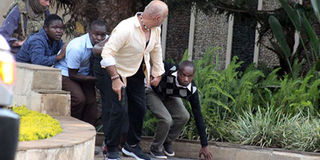How Dusit attack marked recast of local terrorism

Workers are guided to safety by security agents during the rescue operation at DusitD2 Hotel in Nairobi on January 15, 2019. PHOTO | FILE | NATION MEDIA GROUP
What you need to know:
- Within minutes of the first gunshots and explosions, specialised units were on site helping to evacuate people as others combed buildings from floor to floor.
- Journalists were blocked from accessing the scene and the best they could do to get wind of what was going on was to interview evacuated people.
The first sign that something big was happening at Dusit luxury hotel and complex in Westlands, Nairobi, on January 15 came through tweets.
The tweets first came from people who had heard gunshots at the hotel but which quickly escalated into cries for help.
“14 Riverside under massive attack. Gunshots all over, someone out there please help. Thousands of lives in danger,” tweeted Aggie Assimwe Konde.
I remember this tweet because Ms Konde — whom I later learned worked at Msingi offices on the first floor of the building directly opposite DusitD2 Hotel — kept the Nation informed about her ordeal until she was rescued later at night.
Within minutes the newsroom switched to breaking news mode. While everyone agreed that the upscale Dusit complex was under attack, there was uncertainty on whether it was a terrorist attack or a robbery.
Officers from the nearby Australian embassy were the first to respond to gunshots from the complex and confirm that it was a terror attack.
SUICIDE BOMBER
Earlier, a grey Toyota car — with three male occupants — had tried to force its way into the complex following an explosion at the Secret Garden Restaurant on the premises, prompting police officers on guard at the gate to deflate its tyres.
The car’s heavily armed occupants then walked on foot to the first building while shooting at anyone on sight.
An explosion was then heard which later turned out to be the work of a suicide bomber by the name Mahir Khalid Riziki.
It was the first suicide bombing in the history of Kenya. Riziki was a Kenyan homegrown terrorist who had been recruited five years earlier from Majengo in Mombasa and taken to Somalia for training.
He then re-entered Kenya two weeks before the attack with the help of Fawaz Ahmed Hamdun, another homegrown terrorist who was arrested in Mombasa nine months after the attack.
After coming back, Riziki proceeded to Guango estate in Muchatha, Kiambu, to link with the Dusit D2 attack leader — Ali Salim Gichunge, alias Idris, alias Faruk
VIOLET ON THE RUN
Gichunge did not cut the image of a militant, according to conversations I had with his neighbours in Guango estate after the attack.
He was an amiable man easily recognisable by a denim cap he regularly wore. He kept the company of a light-skinned woman, the neighbours said.
The woman, Violet Kemunto Omwoyo, is believed to have escaped to Somalia hours to the Dusit attack and, to date, remains on the ''most wanted list''.
While the attack bore the hallmark of an Al-Shabaab operation, Gichunge, Omwoyo, Riziki, Hamdun and others involved in planning it were all Kenyans.
“It would be a mistake to dismiss the Dusit attack as simply another atrocity perpetrated by Somalia’s pre-eminent terrorist organisation: several key aspects of the operation suggest that it represented a milestone in the realisation of Al-Shabaab’s long-standing ambition to become a genuinely regional jihadi movement,” security think-tank Combating Terrorism Centre said in its July bulletin.
A FINE RESCUE OPERATION
The government, which was still smarting from the bungled rescue operation of Westgate attack victims six years earlier, performed exceptionally well during the Dusit raid. The rescue operation was well executed.
Within minutes of the first gunshots and explosions, specialised units led by the Recce Squad were on site helping to evacuate people as others combed buildings from floor to floor.
They were assisted by security officers attached to various embassies - including the US, the UK and Australia.
Director of Criminal Investigations George Kinoti was the first senior security official at the scene.
Journalists were blocked from accessing the scene and the best they could do to get wind of what was going on was to interview evacuated people.
Within an hour of the attack, the terrorists had been cornered on the top floors of the Dusit hotel.
After 19 hours, President Uhuru Kenyatta, who was forced to cut short his working holiday at the Coast to return to Nairobi, announced that the siege was over.
According to the government, 21 people died and 700 were rescued.





